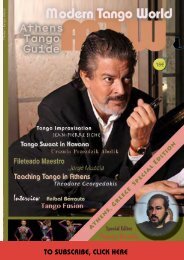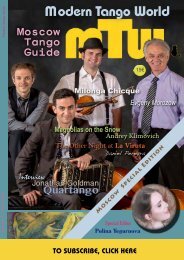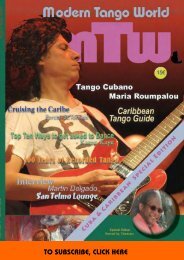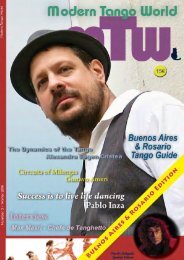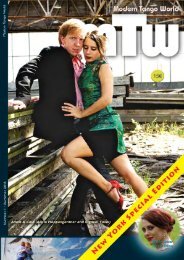Modern Tango World #4 (Bucharest, Romania)
Romania Special Features Romania’s Modern Tango Scene Dragos Samoil 3 An Act of Beauty Laura Iaru 6 Guitar Man Alexandru Eugen Cristea 12 Guide to Tango in Romania 16 The Ladies of Guardia Viejo Renato Mantioni 20 Interview with Miguel di Genova Marco Buso 24 Tango Addiction Kiran Bajaj Sawhney 28 New Tango Music Arndt Büssing 32 The Obamas Tango in Buenos Aires 38 DJ/VJ-ing - Victroleras, Tandas & Cortinas Igor Shpigelman 40 Tango Moves - Abrazos Raymond Lauzzana 44 Letters to the Editor 47
Romania Special Features
Romania’s Modern Tango Scene Dragos Samoil 3
An Act of Beauty Laura Iaru 6
Guitar Man Alexandru Eugen Cristea 12
Guide to Tango in Romania 16
The Ladies of Guardia Viejo Renato Mantioni 20
Interview with Miguel di Genova Marco Buso 24
Tango Addiction Kiran Bajaj Sawhney 28
New Tango Music Arndt Büssing 32
The Obamas Tango in Buenos Aires 38
DJ/VJ-ing - Victroleras, Tandas & Cortinas Igor Shpigelman 40
Tango Moves - Abrazos Raymond Lauzzana 44
Letters to the Editor 47
You also want an ePaper? Increase the reach of your titles
YUMPU automatically turns print PDFs into web optimized ePapers that Google loves.
One Hand Hold (Solo Uno Mano)<br />
Dancers only hold their lead hands, the leader’s left<br />
and the follower’s right. This is most commonly used<br />
as a practice embrace to overcome the leader’s<br />
grasping with the right hand. The right hand should<br />
lightly hold the follower to the frame of their torsos<br />
and should not be used to direct the follower’s<br />
movement<br />
Matched Hand Hold (Mano Contraria)<br />
With the partners facing each other, the leader’s left<br />
hand holds the follower’s right. The leader’s right<br />
hand holds the follower’s left in the embrace.<br />
Close Embrace at the Close Embrace Festival<br />
Champaign, Illinois, USA<br />
This embrace is what in popular terminology is called<br />
cheek-to-cheek. The partner’s cheeks are in contact,<br />
either left-to-right or right-to-right. The embrace<br />
strong and consistant, Often, the followers arm may<br />
be over the leader’s shoulder or wrapped around<br />
his neck. As the name, implies this is a very intimate<br />
form of embrace.<br />
Practice Embrace (Abrazo Practica)<br />
This is the least intimate of all of the embraces. It<br />
used by novice dancers and by instructors with pupils.<br />
There are two forms of practice embrace. In the first<br />
case, both dancers hold each other’s biceps. In the<br />
second form, the follower’s hands are placed on the<br />
chest of the leader to provide a greater connection.<br />
In both cases, the dancers are quite far apart, so that<br />
they may observe each other’s movements.<br />
Hand Holds<br />
Fundamentally, there are only two types of hand holds.<br />
But, in practice there are four. In the standard hand hold<br />
for partner dancing, the leader’s left hand is opened to<br />
receive the open palm of the follower’s right hand. The<br />
leader then closes his fingers around her hand.<br />
No Hand Hold (Sin Manos)<br />
In this hands-free connection between the dancers,<br />
no hands are held. The lead is indicated through the<br />
movement of the upper torso, head turns, and eye<br />
movements. This difficult form of leading and following<br />
is a very important practice hold. It requires a great<br />
deal of concentration and attention to each other.<br />
Rarely do dancers dance an entire song this way. More<br />
commonly, a few moves are made this way, and the<br />
couple returns a matched hand hold.<br />
Same Hand Hold (Misma Mano)<br />
Gentleman’s left hand holds the lady’s left. His right<br />
hand holds her right. This hold is common for Doble<br />
Frente when both partners face the same direction.<br />
Variations<br />
OK, that was the basics. Here come some variations.<br />
There are many more than we have room in<br />
these pages to describe. Here are a few of the more<br />
well-known kinds of embraces and holds. These are<br />
only an idea of the variety of possibilities.<br />
Neck Embrace (Abrazo Cuello)<br />
In a Close Embrace, the follower may place her left<br />
hand around the gentleman’s neck. This may be<br />
enhanced by placing both hands around leader’s<br />
neck. If she does this, the leader places his arms<br />
around her waist.<br />
Hammerlock (Bloqueo de Martillo)<br />
Partners facing each other with opposing hands<br />
held, similar to closed embrace, except that the<br />
follower’s left arm is held behind her back in the<br />
;eader’s right hand.<br />
Teapot Embrace (Abrazo Tetera)<br />
Similar to the closed embrace, except partners raised<br />
arm are in contact at the elbow, so as to form an<br />
upright angle, similar to the spout of a teapot.<br />
Feathered Embrace (Abrazo Plumado)<br />
Partners are offset 50%. Hips overlap, with upper<br />
body torque towards each other.. This may be to<br />
either side, left or right.<br />
Cradled Hold (Cunita)<br />
In cradled holds, the partners face the same direction<br />
with one of the gentleman’s arm wrapped around<br />
her waist, holding her inside hand. The othe hand is<br />
crossed in front holding the gentleman’s other hand.<br />
— 47 —





